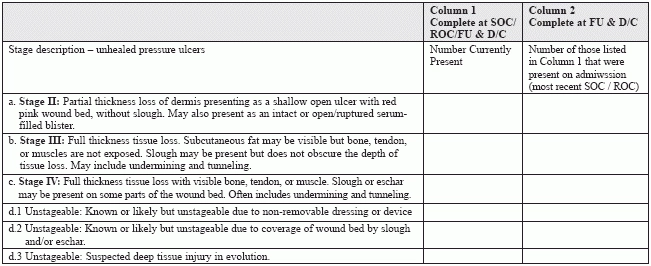OASIS Alert
M1308: Don't Miss the Points for Pressure Ulcers
There’s no need to report Stage I or closed Stage II pressure ulcers for this item.
OASIS item M1308 asks you to report your patient’s current number of unhealed [non-epithelialized] pressure ulcers. Know how to answer this item correctly, and you can earn both NRS and clinical points. But if you’re tripped up by this often confusing item, your agency’s reimbursement will suffer.
What’s at stake: If your patient has two or more Stage III or IV pressure ulcers and you answer M1308 correctly, you’ll earn clinical points. Plus you can earn nonroutine supply points for patients with one to four Stage II to Stage IV pressure ulcers and for unstageable pressure ulcers.

Start with Stage II
M1308 Current Number of Unhealed (non epithelialized) Pressure Ulcers at Each Stage: (Enter "0" if none; excludes Stage I pressure ulcers)
You won’t report any Stage I pressure ulcers in M1308, said Tracie Jones, BSN, RN, CWOCN, WCC, COS-C with At Home Healthcare in Tyler, Texas. That’s because M1308 only applies to Stage II, Stage III, Stage IV, and unstageable ulcers.
You also won’t report any closed Stage II pressure ulcers in M1308, Jones said during her presentation "Master the OASIS-C Pressure Ulcer items & Maximize Outcomes Through The Use of Evidence-Based Treatment Protocols" during the National Association for Home Care and Hospice’s annual meeting in Oct. 2012. That’s because Stage II pressure ulcers that completely epithelialize are considered healed.
On the other hand, you will always report your patient’s Stage III and Stage IV pressure ulcers -- even when they have closed, says Lisa Selman-Holman, JD, BSN, RN, HCS-D, COS-C, HCS-O, consultant and principal of Selman-Holman & Associates and CoDR -- Coding Done Right in Denton, TX.
Here’s why: Closed Stage III and Stage IV pressure ulcers are still counted as pressure ulcers because they have a high likelihood of breaking down again. These full thickness ulcers are considered closed once they are fully granulated, but they will never fully heal. So you will continue to report these closed ulcers at their worst stage, unless they deteriorate, or are replaced by an advancement or muscle flap.
Mind the Time Points
You’ll list a response in Column 1 -- Number currently present at all time points, Jones said. In other words, report the qualifying pressure ulcers your patient has that day. Answer Column 2 -- Number of those listed in Column 1 that were present on admission (most recent SOC/ROC) only at follow up or discharge.
Tip: When completing Column 2, if the pressure ulcers listed in Column 1 were present at the most recent SOC or ROC you’ll report them in Column 2 even if they are currently at a different stage.
One way to check that you are answering Column 2 correctly is to make sure that the number of pressure ulcers in Column 2 isn’t greater than the number listed in Column 1.
Example: At start of care, your patient has two pressure ulcers on her sacrum that cannot be staged due to coverage of the wound bed by slough. To answer M1308 for this patient at SOC, report these unstageable pressure ulcers with a "2" in Column 1, row d.2 and leave Column 2 blank, Jones said.
Now suppose you are completing a follow-up assessment for the same patient. Since SOC, the pressure ulcers have deteriorated. They were debrided and became larger. You can now visualize and palpate muscle which means the pressure ulcers are now Stage IV. To answer M1308 at follow-up, you will report a "2" in Column 1, row c and a "2" in Column 2 row c.
Why? When completing Column 2 in M1308, the previous stage of the pressure ulcer doesn’t matter, Jones said. Instead, focus on whether or not the pressure ulcers you are reporting in Column 1 existed at whatever stage when the last SOC/ROC was completed.
Bottom line: The data collected at M1308 is used to track whether an ulcer develops during a quality episode. To make sure the information you report is accurate, it’s important to document and report all wounds and observations carefully and thoroughly, Northampton, MA-based Fazzi Associates, points out in its OASIS-C Best Practices Manual. In the end, the data you report about your patient’s pressure ulcers will affect your outcomes and eventually your bottom line.
OASIS Alert
- Item Focus:
M1308: Don't Miss the Points for Pressure Ulcers
There’s no need to report Stage I or closed Stage II pressure ulcers for this [...] - Education:
Avoid These Common ADL Item Errors
Could your ADL item response send a patient to the nursing home? The OASIS ADL/IADL [...] - Tool:
Try This Approach to Assessing Ability
Adjust your phrasing for more accurate answers. When it comes to completing OASIS items, there [...] - Assessment:
Follow These Tips for Better ADL Assessment
Do you have an accurate understanding of all that’s involved in toilet transfer? When completing [...] - PPS 2013:
Will Your M1024 Answers Pass Muster?
Fracture codes are the only acceptable M1024 diagnoses this year. The home health PPS revisions [...] - Diagnosis Coding:
Take 3 Steps with Coding for Infected Surgical Wounds
Must you always report a causative organism code? When coding for an infected surgical wound [...] - 2 Tips Help You Prevent Case Mix Loss
Don’t let this assumption do a number on your reimbursement. While you can no longer [...] - ICD-10 Update:
ICD-10: Seven Digit ICD-10 Codes Mirror ICD-9 for Infected Surgical Wounds
Remember to list an additional code to describe the infection. The codes you report for [...] - Industry Notes:
Take Advantage of New OASIS Training Resource CMS has posted a new OASIS web based [...]

